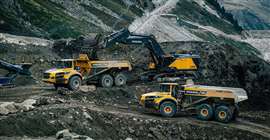Read this article in Français Deutsch Italiano Português Español
High-altitude hydroelectric megaproject in Austria
21 November 2024
Construction is underway on the Kühtai 2 hydroelectric power plant in Austria, with about 200 machines and 620 workers from more than ten countries working in tandem to build a more than 200-million-kwh facility.
 Aerial view of the Kühtai 2 hydroelectric plant construction project in the Austrian Alps. (Image: Volvo CE)
Aerial view of the Kühtai 2 hydroelectric plant construction project in the Austrian Alps. (Image: Volvo CE)
Nestled 2,000m above sea-level in the municipality of Silz in the Tyrolean Stubai Alps, Kühtai 2 is a major development by the Austrian utility company Tiroler Wasserkraft (TW).
The Kühtai power plant will be built underground in a rock cavern that is designed for pumped storage operation and will be powered by two Flensi turbines generating up to 190MW of electricity.
Construction involves several tasks, both under and above ground. Underground includes the construction of an 8km network of supply access tunnels (cleared via drilling and blasting), as well as a 25.5km bypass tunnel with a diameter of 4.2m, which will be excavated by an 800-tonne tunnel boring machine (TBM).
 Peter Wetzlinger (Image: Volvo CE)
Peter Wetzlinger (Image: Volvo CE)
“This is a gravity tunnel in which water is drawn in via six water intakes at a rate of up to 13.5m3 per second,” said Peter Wetzlinger, project manager of Swietelsky – one of three construction management firms working the site (alongside Jäger Bau and Bodner).
The bypass pipeline will open new catchment areas in the central and eastern Öztal valley and the rear section of the Stubaital valley and deliver water into the new Kühtai reservoir. The reservoir will have a storage volume of 31-million-m3 and will fill up two-and-a-half times a year, typically in spring and autumn.
Wetzlinger noted, “In order to fill the reservoir, a 7-million-m3 dam, with a crest length of 500m and height of 106m, is being constructed.”
In total, TW has invested approximately US$1 billion on the scheme to expand its existing system of power plants in the Sellrain-Silz region.
Construction is expected to finish in 2026.
A peek at the machine works on the Kühtai 2 project
 Volvo CE machines work the Kühtai 2 site in Austria. (Image: Volvo CE)
Volvo CE machines work the Kühtai 2 site in Austria. (Image: Volvo CE)
Sweden-based construction equipment manufacturer Volvo Construction Equipment (Volvo CE) has about 60 machines on site. The company said a brand-new Volvo EC950F is the flagship of the project excavator fleet.
The OEM added that its largest crawler excavator (a 90-tonne unit) is the first of its kind in Austria, with a second EC950F set to join the Kühtai 2 build soon.
“Twenty-six Volvo articulated haulers, varying in size from the A25 to the A60 – the largest articulated hauler on the market – perform the real backbone of the work on the site,” said Volvo CE. “Fourteen A25 and A30 haulers alone are used for underground work and blasting, transporting material away.”
Wetzlinger explained further some of the daily machine processes.
“We optimise the cross-sections so that the loading cycles with the Volvo L120, L150 and L180 wheel loader fit the A25 and A30 perfectly,” he said.
Larger hauler models were selected for earthworks due to improved off-highway capabilities. “We needed articulated haulers because the rigid haulers can’t get everywhere, especially in certain areas of the quarry,” added Wetzlinger. “And we can’t create highways. We need all terrain and all-wheel drive vehicles.”
Each week 30-40 articulated haulers transport about 25 tonnes of bentonite each, which is mixed with a core material before delivery around the site.
Wetzlinger said, “Due to the one-way operation, the routes are getting longer, so we are changing the machine fleet and getting more A60 haulers and another large EC950F excavator to help ensure we install the material on time.”
He continued, “All material extracted from the underground area is recycled, with loose rock installed in the dam. In addition, we have to blast 2.2-million-m3 of rock – that’s around 50–60,000m3 a week. We’re using [45 tonnes] of explosives per week and around 16,000l of diesel per day.”
Fuel-savings at high-altitude for Volvo CE excavator
 A fleet of Volvo CE machines at the Kühtai 2 site in Austria. (Image: Volvo CE)
A fleet of Volvo CE machines at the Kühtai 2 site in Austria. (Image: Volvo CE)
Fuel usage has been slightly lower than an average site closer to sea level, as machines typically consume less fuel in high-altitude settings.
The Volvo EC950F, in particular, was operating around 50-55l of diesel daily.
“We didn’t believe it at the start, and thought the machine would consume more,” says Wetzlinger. “But [the dealer’s] predictions proved correct.”
STAY CONNECTED


Receive the information you need when you need it through our world-leading magazines, newsletters and daily briefings.
CONNECT WITH THE TEAM












